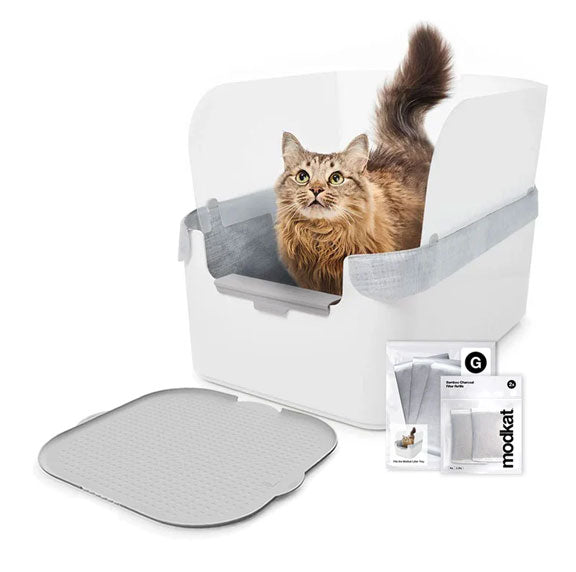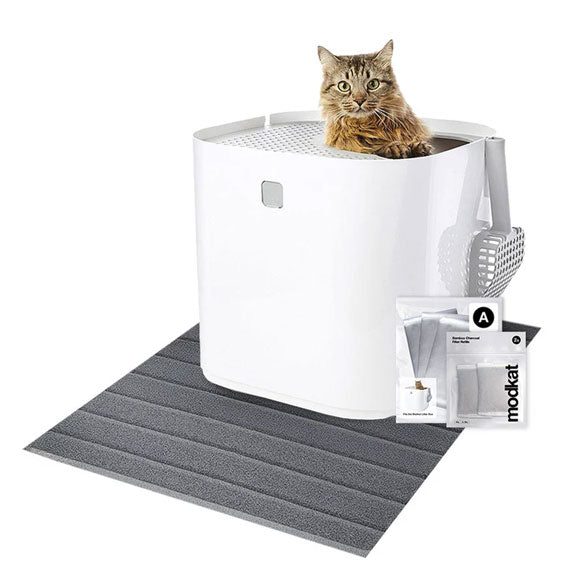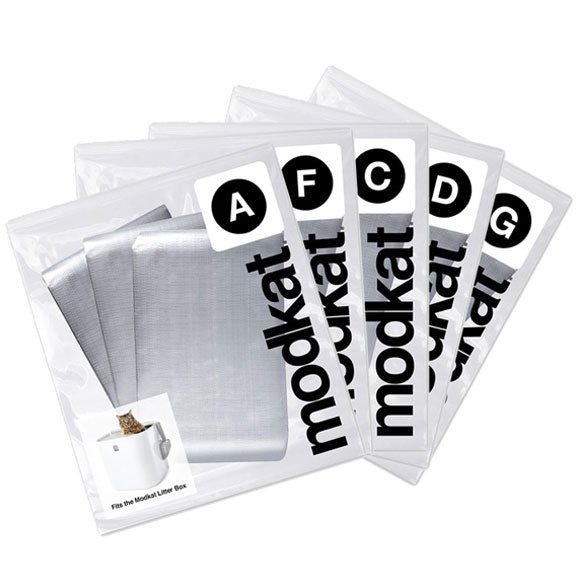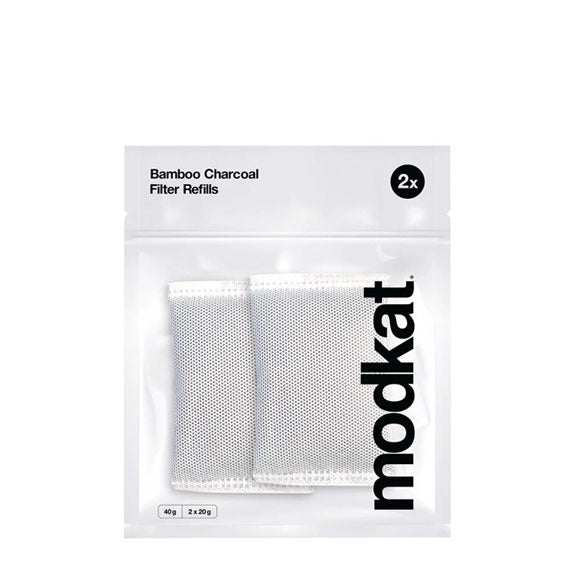20% off sitewide. Discount automatically applied.
20% off sitewide. Discount automatically applied.
Litter Boxes
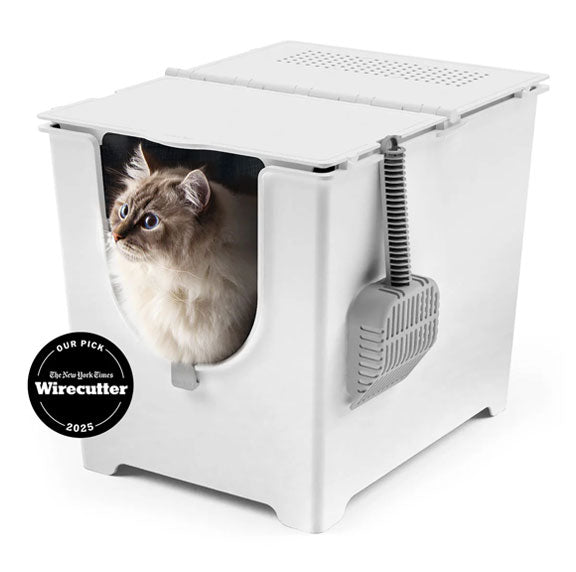
Modkat Flip
Front-Entry Litter Box

Modkat XL
Front/Top-Entry Litter Box
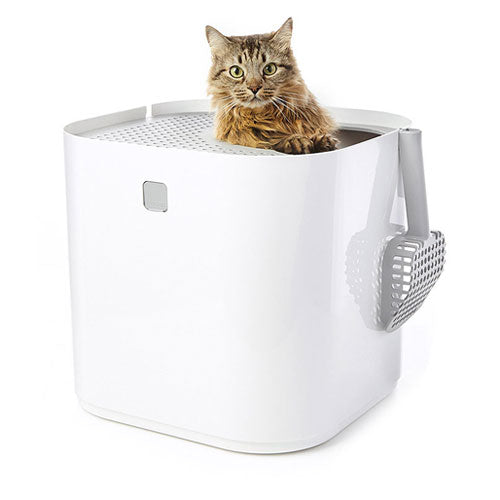
Modkat
Top-Entry Litter Box
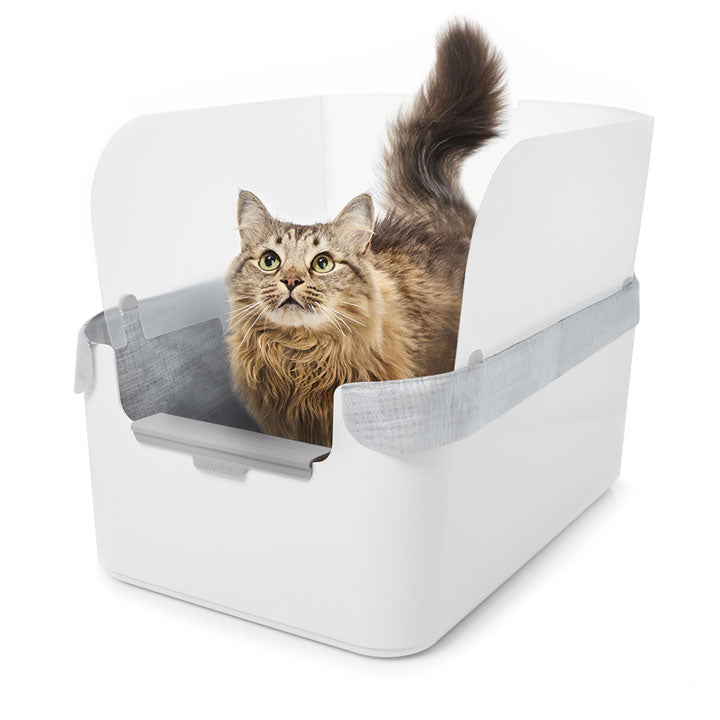
Modkat Tray
Open Litter Box
Bundles
Essentials

Litter Keeper
Two colors
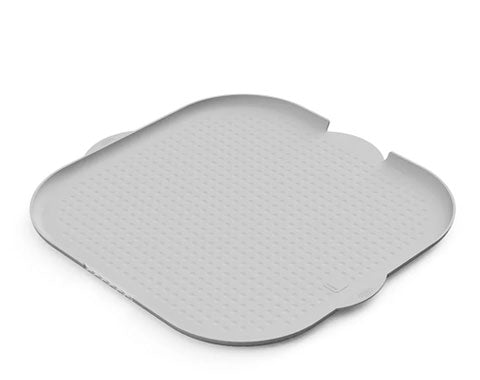
Litter Mats
Multiple styles, colors & sizes

Tidy-Up Kit
Scoop holder & dustpan
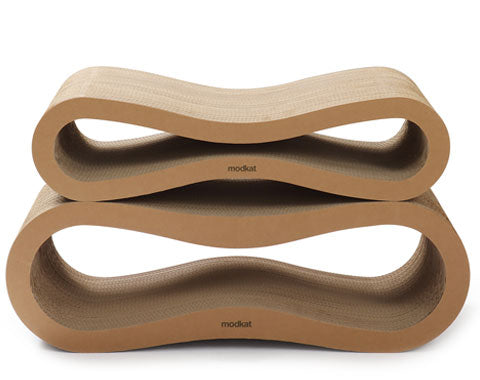
Lounge + Play
Scratchers & toys
Refills
Add description, images, menus and links to your mega menu
A column with no settings can be used as a spacer
Link to your collections, sales and even external links
Add up to five columns
Add description, images, menus and links to your mega menu
A column with no settings can be used as a spacer
Link to your collections, sales and even external links
Add up to five columns
Ultimate guide to the world's most popular cat breeds.
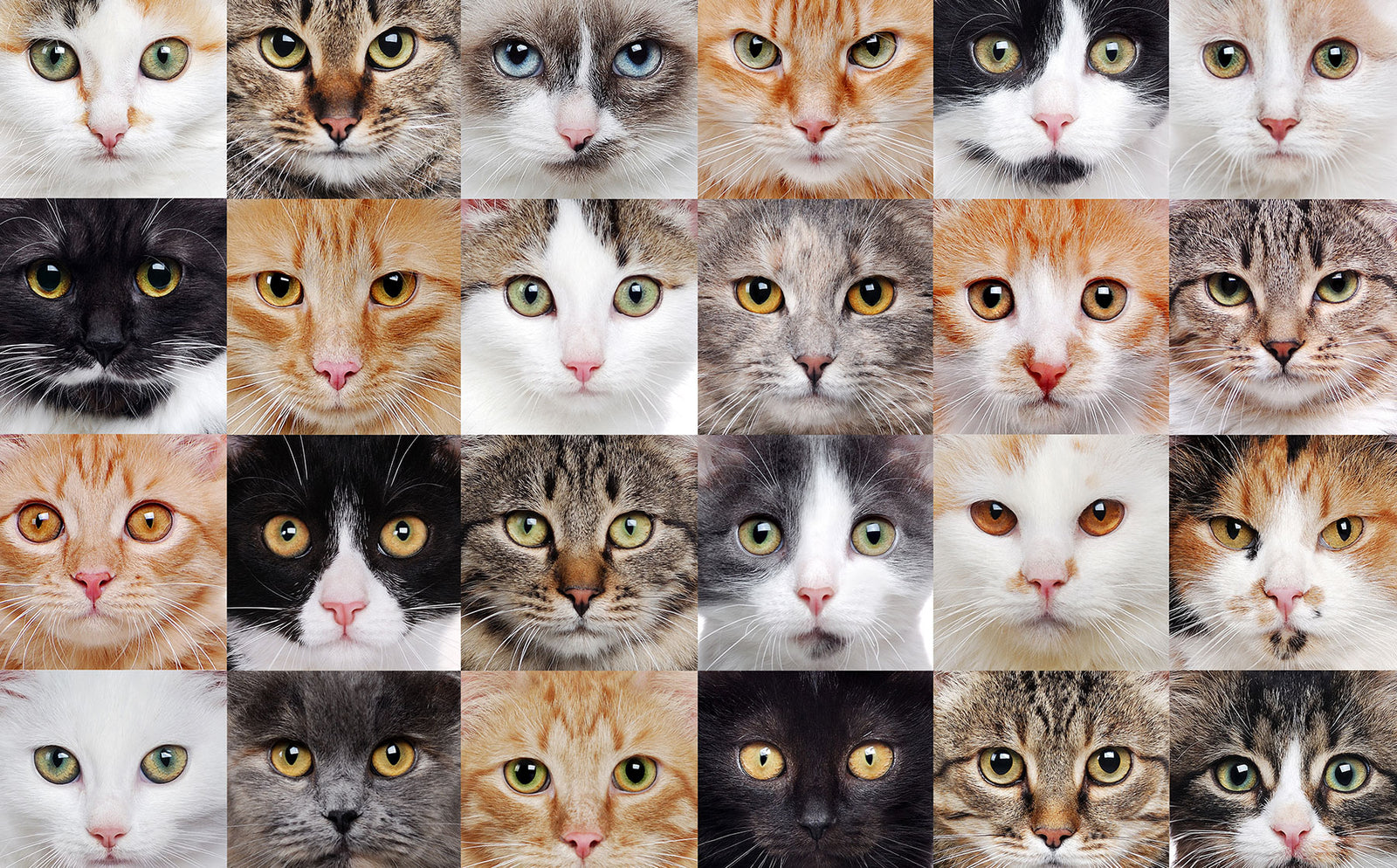
Cats have been domesticated for about 10,000 years. Those first kitties followed human communities around the Fertile Crescent to take advantage of the rodent population that enjoyed snacking on community trash.
Today, 94.2 million pet cats make themselves comfortable in American homes. And in 91 countries around the world, though not the U.S., pet cats outnumber their canine cousins.
At Modkat, we love all kinds of cats — small, tall, curly-haired, short-haired, hairless, young, old, and in-between. Kitty snuggles of all kinds make us happy. But not all cats are alike.
Different breeds bring their own distinctive characteristics to their human families. The guide below provides a glimpse into the best of some of the world's most popular cat breeds. Learn more about your kitty or find out which cat might be right for your family.
Abyssinian
Origin: Abyssinian cats received their name from the region of Abyssinia, now called Ethiopia, where they were said to have originated. Cat geneticists now believe the animals first appeared on the coast of the Indian Ocean, however, and traveled to Ethiopia with British soldiers in the 1860s.
Personality: These animals are among the most popular cat breeds due to their active, playful personalities.
Description: Fine-boned and medium-sized, Abyssinians' distinctive look comes from its ticked coat, caused by a mutant gene.
Lifespan: Up to 15 years
Amazing Fact: Archaeologists have discovered mummified cats similar to the Abyssinian in the tombs of the ancient Egyptians.
American Bobtail
Origin: The first American Bobtails appeared in the 1960s after breeders crossed a female Siamese cat with a male tabby who had a short tail.
Personality: Affectionate and easygoing, American Bobtails can live in rowdy households, travel with truck drivers, or serve in psychological treatment programs .
Description: American Bobtails can weigh 7-16 pounds, have shaggy hair, and may be any color or pattern. They must have the distinctive short tail of their breed.
Lifespan: 13-15 years
Amazing Fact: The tail of an American Bobcat is about ⅓ to ½ as long as a typical cat's tail.
American Shorthair
Origin: Cats have lived on American soil about as long as Europeans. The records from Jamestown, the first British settlement in the New World, mention the colony's cats. In 1904, the first American-born cat, named Buster Brown, was actually registered under the name "shorthair."
Personality: Quiet, sociable, and adaptable, American Shorthairs have won their place in the canon of cattery. These animals are active and quiet with a sharpened hunting sense.
Description: American Shorthairs come in a variety of colors and patterns. These cats sport round, full cheeks that give them a cheerful appearance.
Lifespan: 15 years or longer
Amazing Fact: American Shorthairs descend from cats that came over on the Mayflower. At that time, most ships welcomed cats as passengers to help control the rodent population.
Balinese
Origin: In the early 20th century, Siamese cats began giving birth to long-haired litters. The reasons for this mutation remain debated, but by 1970, all the major cat associations had accepted the long-haired Siamese offspring, now called the Balinese.
Personality: Smart, active, and playful, the Balinese offers a chatty and cheerful companion. These athletic animals often enjoy riding on their humans' shoulders and playing with balls and toys.
Description: Much like their Siamese ancestors, Balinese cats feature a long, slim body with a fine bone structure. Their long coats can come in multiple colors.
Lifespan: 12-20 years
Amazing Fact: Even though the breed is named for the Indonesian island of Bali, the Balinese cat actually comes from the good ol' U.S.A.
Bengal
Origin: Created by Jean Sudgen Mill, an American conservationist, the Bengal emerged from a cross between a domestic cat and an Asian Leopard Cat — Mill's particular interest. The unique merger fashioned an animal with the look of a wildcat and the personality of a pet.
Personality: One of the most intelligent and athletic cat breeds, Bengals have an excellent memory and a disposition for learning cool tricks. Much like dogs, Bengals can be taught to follow commands such as "sit," but they can also learn to switch off the lights or open lids. Bengals also have an unusual fascination with water and will leap tall buildings in a single bound just to get at a dripping tap.
Description: Bengals look like miniature leopards. Snow Bengals sport a white or light brown pattern due to a recessive gene.
Lifespan: 12-16 years
Amazing Fact: Some of the most expensive pet cats in the world, Bengals typically run between $600 and $7000. The priciest Bengal ever, a feline fellow named Cato, sold for $41,435 in 1990.
Bombay
Origin: A Kentucky cat breeder named Nikki Homer developed a pure-black cat she called the Black Mamba in 1965. Homer crossed a sable Burmese with an American Shorthair to create this new breed. Bombays were named after the Indian port city of Bombay even though they originated in Louisville, KY.
Personality: Bombays have been described as both bossy and social. One writer styled these pets "the Velcro Cats" because they stick so close to their humans.
Description: Bombays resemble miniature black panthers.
Lifespan: 12-20 years
Amazing Fact: Bombays are among the world's longest-lived pet cats.
British Shorthair
Origin: The first cats actually came to the British isles asrodent-catchers who accompanied the Roman army. It wasn't until the Victorian Era, however, that breeders began refining the ancestry of the British Shorthair.
Personality: Relaxed, friendly, and cuddly, these large cats enjoy sitting next to their people.They're known for their affectionate natures although most of these cats don't enjoy being picked up.
Description: Stocky and dense with a broad face, British Shorthairs can come in a variety of patterns and colors, including British Blue, which features a grey-blue coat and orange eyes.
Lifespan: 12-20 years
Amazing Fact: Two of the best known cats in literature, Puss in Boots and the Cheshire Cat from Alice in Wonderland, were British Shorthairs.
Burmese
Origin: In 1936, a sailor gave a small brown cat from Burma (now Myanmar) to Dr. Joseph Thompson, a cat breeder. Thompson bred her with a Siamese, producing a new kind of cat. In 1979, the International Cat Association recognized the Burmese as an official breed.
Personality: Charming, trusting, and chatty, Burmese cats are among the sweetest and most fun breeds that cat lovers can welcome into homes with children.
Description: Burmese cats come in four colors, sable, champagne, platinum, anb blue. They typically have yellow eyes, but some Burmese feature baby blue peepers.
Lifespan: 10-17 years
Amazing Fact: Almost all Burmese cats can trace their genealogy back to the same ancestor — a cat named Wong Mau.
Burmilla
Origin: The first Burmilla cats emerged from an "accidental" mating between a bewitching Burmese babe and a silver male Persian Chinchilla.
Personality: Most Burmillas are affectionate and placid animals. These cats enjoy interacting with their human families.
Description: Medium-sized but muscular, the Burmilla weighs about 8-12 pounds and comes in several colors such as balck, blue, lilac, caramel, and apricot. Burmillas can be shaded or tortoiseshell.
Lifespan: 7-12 years
Amazing Fact: The mother of all Burmillas was named Faberge, and the father was a fellow called Sanquist.
Calico
Origin: The orange color originated in Egypt and began to mix with other colored cats in the Mediterranean region. As of 2001, the calico is the State of Maryland's official cat.
Personality: Often sweet and affectionate, calico cats have a reputation for being strong-willed and determined.
Description: Calico cats are usually orange, black, and white. But any tri-colored cat technically qualifies as calico.
Lifespan: 12-15 years
Amazing Fact: You can't breed a calico cat because 2,999 of every 3,000 calico cats born are female. And that one lonely male? He's sterile.
Chartreaux
Origin: Legend holds that the monks of Chartreaux bred these cats to be quiet companions during meditation. But the monastery's records do not support this story. The Chartreaux cat does get a mention in a book of natural history published in 1749.
Personality: Chartreaux cats are known for being quiet and strong. They generally love hunting and playing with toys. They can become deeply attached to their people.
Description: Featuring a broad head and shoulders, the Chartreaux has surprisingly short legs and dainty feet. These cats can be blue-gray, ash, or slate colored with brushed silver tips on their fur.
Lifespan: 8-13 years
Amazing Fact: The most famous French president, Charles de Gaulle, received a Chratreaux cat as a gift from his wife. The animal's name was Ringo de Balmalon, but de Gaulle called him "gris-gris," which means "gray-gray."
Chausie
Origin: Chausies emerged from an intermingling of domestic shorthair cats and wild jungle cats. These animals first appeared on the banks of the Nile River in Egypt.
Personality: Energetic, playful, and energetic, the Chausie needs lots of playtime and plenty of affection to fill up their big personalities.
Description: Male Chausies weigh between 11 and 16 pounds, and females tip the scales between eight and 13 pounds. Officially, these animals come in three colors — solid black, black grizzled tabby, and black (brown) ticked tabby. They usually have golden eyes although other colors are allowed.
Lifespan: 9-15 years
Amazing Fact: Chausie cats can jump to a height of almost 6.5 feet.
Cornish Rex
Origin: In 1950, Nina Ennismore, a woman who raised rex rabbits at her home in Cornwall, England, noticed a curly-haired kit among her barn cat's new litter. She took the baby into her home and christened him Kallibunker. Seven years later, some of Kallibunker's descendants arrived in the U.S. where breeders began to establish the Cornish Rex breed.
Personality: Looking for a kitty who loves to run, jump, and play fetch before snuggling down beside you? A Cornish Rex may be just the pet for you.
Description: A small-boned and long-legged animal, the Cornish Rex's most distinctive feature is its curly hair. This cat breed features a slender tail, large ears, and a strong chin.
Lifespan: 12-15 years
Amazing Fact: In addition to its curly coat, the Cornish Rex also models curly eyebrows and whiskers.
Cymric
Origin: Cymric cats first appeared on the Isle of Mann, which lies between England and Ireland. The somewhat isolated and self-contained location permitted genetic mutations to go unchecked, resulting in the Manx and the Cymric in 1750.
Personality: Sweet and placid, these cats make adorable pets for people looking for a calm companion.
Description: You can find the Cymric in a clowder of cats by looking for the one with no tail. Cymrics are the longhaired cousins of the tailless Manx cat.
Lifespan: 9-13 years
Amazing Fact: Legend has it that this cat's ancestor was late to the Ark, and Noah closed the door on its tail just as it was sneaking in.
Devon Rex
Origin: Ms. Beryl Cox of Devonshire, England discoverd the Devon Rex in the 1950s when she took in a stray cat.
Personality: Devon Rex cats love to have fun! They're adorable, silly animals who love snuggling with their humans and learning tricks.
Description: Short-haired, long-eared, and wavy-coated, the Devon Rex can't be mistaken for anything but itself. These animals sometimes get lumped in with their Cornish Rex cousins, but the Devon sports shorter, stockier legs.
Lifespan: 10-20 years
Amazing Fact: All Devon Rex cats descend from a single tomcat named Kirlee.
Egyptian Mau
Origin: The Egyptians were sculpting, drawing, and writing about their cats 5,000 years ago. The breed eventually became popular with European nobility in the early 1900s before nearly dying out during the world wars.
Personality: Though friendly, Egyptian Maus tend to be quite shy. They often bond with just a few people and other animals, making them excellent companions in small, single-cat households.
Description: The Egyptian Mau features a short coat spotted with dark splotches. These animals also appear to wear mascara around their wideset, gooseberry-green eyes.
Lifespan: About 15 years
Amazing Fact: Natalie Trubetskaya, a Russian princess living in exile in Italy after World War II, rescued the Egyptian Mau breed. When Trubetskaya moved to New York, she brought her three beloved cats with her and established the Fatima Egyptian Mau cattery from which most modern Egyptian Maus are descended.
Exotic Shorthair
Origin: Exotic Shorthairs got their start in the 1950s when cat breeders tried to develop a cat that had the good looks of the Persian but the low-maintenance style of an American Shorthair.
Personality: Playful, friendly, and curious, Exotic Shorthairs love their people. These cats need lots of attention along with a little downtime to restart the engines.
Description: The Exotic Shorthair's short, plush coat comes in all colors and patterns. These animals have a flat face and nose similar to their Persian ancestors.
Lifespan: About 15 years
Amazing Fact: Exotic Shorthairs have appeared in several movies and TV shows, including Cats & Dogs (2001), Cats & Dogs: The Revenge of Kitty Galore (2010), and the Fox sitcom New Girl.
Havana
Origin: Solid brown cats appeared in Siam (now Thailand) sometime between 1350 and 1767. The modern Havana cat, however, traces its history to 1952 when a chocolate-brown beauty appeared in a British litter.
Personality: Intelligent and playful, Havana cats seem to enjoy helping their humans around the house. You can spot them carrying small objects from place to place when they aren't keeping company with their people.
Description: Accented by green eyes and a long tail, the Havana's warm brown coat lies close to its skin. This animal sports a sleek, luxurious look that is as appealing as its personality.
Lifespan: 8-13 years
Amazing Fact: The Havana received its name either from a brown rabbit called the Havana or from the Havana cigar whose color the cat resembles.
Himalayan Cat
Origin: Geneticists and researchers began trying to cross a Siamese cat and a Persian cat as early as 1925. By the 1950s, breeders had managed to create a cat with the sleek body of the Siamese and the long hair of the Persian. All the major cat associations in the U.S. recognized this cat as a Himalayan by 1961.
Personality: Gentle, calm, and sweet, "Himmies" possess the gentle, playful nature of their Siamese ancestors blended with the independent nature of the Persian.
Description: Himalayan cats feature a firm, lithe body covered in long hair that can come in pointed colors and patterns.
Lifespan: 9-15 years
Amazing Fact: Himalayan cats have no connection to the high Asian mountain range of the same name. Instead, they're named after the Himalayan rabbit, an animal the cats resemble.
Japanese Bobtail
Origin: The ancestors of the modern Japanese Bobtail sailed on boats between Japan, Korea, and China as early as the sixth century, making the breed one of the oldest in the world. Most likely, these animals protected silks from damage by rodents. The breed came to the U.S. in 1967, and today, all North American cat associations accept the Japanese Bobtail.
Personality: Smart, playful, and agile, Japanese Bobtails make excellent pets. These animals get along well with other cats, dogs, and children; and they enjoy playing a variety of cat-friendly games.
Description: With back legs slightly longer than the front, the Japanese Bobtail shows a strong, muscular look. This cat can come in any number of colors or patterns and is known for its short and silky fur.
Lifespan: About 15 years
Amazing Fact: While Japanese Bobtails typically sport either gold or green eyes, sometimes a cat will have one eye of each color, a condition called heterochromia.
Javanese
Origin: Crossing a Balinese to a Colorpoint Shorthair produced the Javanese, a descendant of the Siamese. The Cat Fanciers Association recognized the long-haired version of this breed in 1987.
Personality: Similar to their Siamese relatives, Javanese are faithful and chatty companions. They're playful, smart, and active with a friendly disposition. Since they're curious and interactive, Javanese thrive in homes where they can receive plenty of human attention.
Description: Similar to the Balinese and the Siamese, these cats feature a firm, sleek appearance. The Javanese can have either long or short hair.
Lifespan: 8-12 years
Amazing Fact: Javanese cats carry fewer allergens on their fur than most other cats, making them great pets for many allergy sufferers.
Korat
Origin: One of the world's oldest cat breeds, the Korat is a rare — and beautiful — animal that first received recognition by Thai writers between the 14th and 18th centuries. In Thai culture, the Korat represented health, prosperity, and good luck. In 1959, an American cat lover named Jean Johnson received a pair of Korats from friends in Thailand. She began developing the breed for a U.S. population.
Personality: Korats offer their families a sweet, quiet companion. These animals are affectionate and intelligent but tend to keep to themselves rather than jump into the hustle and bustle of a busy home.
Description: Their distinctive blue-silver fur distinguishes Korats from other cats. The fur tips can give the cat a glowing appearance. These animals are born with blue eyes that change to amber and eventually to a phosphorous-green.
Lifespan: About 15 years
Amazing Fact: In Thailand, Korat cats represent luck and prosperity.
LaPerm
Origin: In 1982, a barn cat in Oregon gave birth to a bald cat with a tabby pattern on her skin. Soon, the kitten began to grow curly hair, so her people named her Curly. After reaching maturity, this kitty gave birth to several litters, and many of her kittens showed their mother's distinctive curly hair. These animals formed the foundation of the LaPerm breed.
Personality: Active and affectionate, LaPerms often enjoy people, other pets, and lots of activities. They're especially fond of heights and will often ride around on people's shoulders.
Description: The LaPerm features curly fur that comes in many lengths, colors, and patterns.
Lifespan: 10-14 years
Amazing Fact: Despite the flashy French name, the LaPerm actually descends from an Oregon barn cat named Speedy.
Maine Coon
Origin: One of North America's oldest natural breeds, the Maine Coon's origins are shrouded in history. Possibly, the animal resulted from a match between a Norwegian Forest Cat and a Siberian. Regardless of its history, the Maine Coon has become one of the most popular cats in the U.S.
Personality: Maine Coons are so affectionate and friendly that they've been characterized as the dogs of the cat world. They love their families and will even come when called. Maine Coons love to cuddle and show above average intelligence.
Description: One of the largest domestic breeds, the Maine Coon stands 10-16 inches tall and runs about 40 inches in length. These gentle giants can weigh 8-12 lbs if female or 13-18 lbs if male. They come in 85 coat colors and color combinations.
Lifespan: 13-14 years
Amazing Fact: The Maine Coon is the official cat of the State of Maine.
Manx
Origin: In the 19th century, Manx cats first emerged on the Isle of Man, located between England and Ireland. These animals descended from house cats from nearby locations. Like other cats in the British Isles, the Manx descends from the African wildcat.
Personality: Often described as sweet and gentle by their caregivers, the Manx typically show signs of unusually high intelligence. These animals may be shy around strangers, but they tend to be fun-loving and gregarious with family members.
Description: You can recognize a Manx from its short, stubby tail. Sometimes, these animals have no tail at all. The Manx can be short haired or long haired, but they usually have golden eyes.
Lifespan: 9-13 years
Amazing Fact: Some Manx cats have reportedly learned to open doors to rooms containing things the cats want.
Munchkin
Origin: Short-legged cats have been around since the 1940s, but Sandra Hochenedel, a music teacher in Rayville, Louisiana, and her friend Kay LaFrance, bred the first modern Munchkin in 1983. The breed received recognition from The International Cat Association (TICA) in 1995.
Personality: Don't let their small size fool you. These little cats have big personalities. They are friendly, full of energy, and great with children. Munchkins usually love people, other pets, and active play. Some people call them, "the dachshunds of the cat world."
Description: Munchkins stand about 5 to 7 inches high. Their short coats can come in a variety of colors and patterns. They usually weigh between 6 and 9 pounds in adulthood.
Lifespan: 12-15 years
Amazing Fact: Munchkins can sit upright like rabbits and prairie dogs.
Nebelung
Origin: Cora Cobb, a cat fancier in the U.S., began the Nebelung line when she bred her two blue-gray cats, Siegfried and Brunhilde, with each other in the mid-1980s. The breed has received recognition from the major cat associations.
Personality: The Nebelung's many admirers describe the animal as gentle, playful, and active. These cats are often intelligent and graceful. Their mild-mannered personalities and beautiful coats make them excellent companions in nearly any home.
Description: Sometimes called "the long-haired Russian Blue," the Nebelung certainly resembles its cat cousin. These feline beauties feature medium-length blue-gray hair, medium-sized bodies, and a charcoal-gray nosepad.
Lifespan: 15-18 years
Amazing Fact: In German, "nebelung" means "creature of the mist."
Norwegian Forest Cat
Origin: The Norwegian Forest Cat originated in Norway as far back as 1000 CE. These animals adapted to survive in Scandinavia harsh winters. The breed nearly went extinct during World War II but flourished again in the 1970s. Today, Norwegian Forest Cats make popular pets across Europe and North America.
Personality: Friendly and intelligent, Norwegian Forest Cats enjoy active play and chatting with the human family members. Their ancestors served as mousers on Viking warships, and today's Norwegian Forest Cats continue that tradition as great hunters.
Description: Norwegian Forest Cats feature tabby-white medium-long fur, almond-shaped eyes, and a triangle-shaped head. They come in many colors and patterns except lilac, fawn, cinnamon, and chocolate. Norwegian Forest Cats are known for their tufted ears and toes.
Lifespan: 8-14 years
Amazing Fact: Norwegian Forest Cats drew the chariot of Freya, the Norse goddess of love and beauty.
Ocicat
Origin: Though they look like wildcats, Ocicats actually descended from a mix of Siamese and Abyssinian cats. These domestic animals first received recognition in 1966 and later joined the ranks of approved cat breeds in the 1980s.
Personality: Affectionate and playful, Ocicats enjoy undertaking highwire acts like their Abyssinian ancestors. Most Ocicats also relish the opportunity to spend time with other pets and people but generally like to bond with just one person.
Description: Ocicats have almond-shaped eyes, oval-shaped paws, and a wedge-shaped head, giving them a muscular, healthy appearance. These animals feature spotted coats much like wildcats.
Lifespan: 15-18 years
Amazing Fact: This animal is almost a perfect facsimile of the wild ocelot that prowls throughout the southwestern U.S. and Central and South America.
Oriental Shorthair
Origin: Though its genetic lineage stretches to Thailand, the Oriental Shorthair is actually the brainchild of New York cat breeders who developed a love of Siamese variations in the early 1970s.
Personality: Much like their Siamese relatives, Oriental Shorthair cats have affectionate, fun-loving personalities that capture the hearts of their people. These animals enjoy chatting, cuddling, and assuaging their boundless curiosity.
Description: The Oriental Shorthair shows much the same body, head, and ears as a Siamese cat, but these fellows can come in more than 300 coat and color combinations.
Lifespan: About 15 years
Amazing Fact: Some observers believe that the Oriental Shorthair is the most intelligent cat breed in the world.
Persian
Origin: Persians probably originated in the country whose name they bear. These animals became wildly popular as pets in England during the Victorian era.
Personality: Persians often exhibit serene, reserved personalities that fit their sense of style. These cats may enjoy playing with family members or leaping to the tops of high bookcases, but they are unlikely to engage in a rough game of tag with children or other pets.
Description: Featuring a pushed-in face and long hair, Persians can be soft or silky. Among the most beautiful cats, Persians are also one of the highest maintenance felines. They need regular combing, brushing, trimming, and washing.
Lifespan: 10-17 years
Amazing Fact: Persians appeared at the world's first cat show, held in England in 1871.
Peterbald
Origin: Peterbalds come from Russia. Olga S. Mironova, a Russian felinologist, experimentally bred an Oriental Shorthair with a Don Hairless. That tryst produced the Peterbald in 1994.
Personality: Peter balls typically enjoy the company of dogs, people, and other cats. These animals tend to be good with children and bring plenty of curiosity, energy, and affection to their families.
Description: While these animals can be born with some hair, adult Peterbalds are hairless. These cats also feature a narrow head, almond-shaped eyes, and a wedge-shaped muzzle.
Lifespan: 12-15 years
Amazing Fact: The Peterbald is one of only six known hairless cat breeds in the world.
Pixiebob
Origin: The Pixiebob probably began as the offspring of a bobcat and a domestic shorthair. But in 1985, a woman named Carol Ann Brewer received a cat with polydactylism (more than the usual number of toes). Carol eventually acquired another cat with the distinctive coat markings of a Pixiebob and soon launched a new breed.
Personality: Pixiebobs are often fond of their people and enjoy chatting, solving puzzles, and playing rough-and-tumble games. These animals are so sturdy and active that children may need special help learning to be gentle with their seemingly indestructible playments. Pixiebobs can learn to play fetch and walk on a leash.
Description: This cat's thick, all-weather coat comes in long and short varieties. The Pixiebob can be any shade of brown with mascara markings around the eyes and spots on the belly.
Lifespan: About 15 years
Amazing Fact: Pixibobs are the only cats that must be polydactyls to participate in cat shows.
Ragamuffin
Origin: All Ragamuffins trace their lineage back to a single cat named Josephine. This cat wasn't a Ragamuffin at all, though. She was a Ragdoll. At the time, many Ragdoll owners crossbred their animals with other longhaired cats, including THimalayans, Persians, and Turkish Angoras.
Personality: Sweet, docile, and friendly, ragamuffins get along well with children and other pets. These cats enjoy plenty of attention from their people along with regular play time and even walks on a leash. Their playful natures make them great feline family members.
Description: Female Ragamuffins tip the scales at 10 to 15 pounds. Males can weigh more than 20 pounds. These animals feature a medium-length coat that can come in many colors and patterns.
Lifespan: 15-18 years
Amazing Fact: The Ragamuffin is the 33rd most popular feline breed.
Ragdoll
Origin: Cat breeder Ann Baker first developed the Ragdoll at her home in Riverside, California in the 1960s. She selected long--haired cats with sweet, placid personalities and beautiful coats.
Personality: Ragdolls get their name from their propensity to go limp in the arms of people. These cats adore humans. They can learn to come when called, retrieve toys, and even do tricks. Ragdolls love snuggling and cuddling almost as much as they enjoy playing.
Description: Ragdolls are large cats with broadheads and medium-sized ears. Their long fur can feature any of a variety of patterns and colors.
Lifespan: About 15 years
Amazing Fact: Ragdolls can grow up to a whopping size of 20 pounds, which with their long hair, can make them resemble a small dog.
Russian Blue
Origin: Though legend says these animals paced the halls of the Czars' palaces, the Russian Blue likely originated in Northern Russia. The cats made their way across Europe on ships. The first Russian Blue to appear in public in England did so in 1875 at London's Crystal Palace where it was exhibited as "the Archangel cat."
Personality: Social, sweet-tempered, and highly intelligent, the Russian Blue needs more mental and physical stimulation than the average housecat. These active animals need constant access to toys and regular interaction with people though they may shy away from visitors they don't know.
Description: The Russian Blue's straight, double-edged coat comes in dark gray tipped in silver. As kittens, these cats have pretty yellow peepers, but adult Russian Blues feature dazzling green eyes.
Lifespan: 15-20 years
Amazing Fact: Russians get their blue-toned fur from a diluted version of the gene for black hair.
Savannah
Origin: Savannah cats originated in the late 20th century, the offspring of a Siamese cat who mated with a wild serval.
Personality: Active and athletic describe the Savannah. These cats can leap up to 8 feet high. They enjoy the outdoors, and they love water. Your Savannah cat may even jump in the kiddie pool or the bathtub with you.
Description: Standing up to 17 inches and weighing as much as 25 pounds, Savannahs are recognizable by their long legs, large perked ears, and spotted coats. Their short-dense coats can come in black, brown spotted tabby, silver spotted tabby, or black smoke.
Lifespan: About 20 years
Amazing Fact: Savannah cats love water. They will join their people in the shower, and some even enjoy swimming.
Scottish Fold
Origin: Records of cats with folded ears go back to 1796, but the first modern Scottish Fold was born in 1961 in (where else?) Pertshire, Scotland.
Personality: The Scottish Fold is a social butterfly. These Sweet, charming, and affectionate animals make great pets for the whole family provided children are taught to be gentle with the animal's sensitive tail.
Description: Besides the distinctive folded ears, Scottish Folds often feature two different colored eyes. Their fur can be long or short and may come in solid, bicolor, partial-color, tabby, or tabby and white.
Lifespan: 11-15 years
Amazing Fact: Cats with folded ears have been observed since the 1700s, but all Scottish Fold cats can trace their lineage back to Susie.
Selkirk Rex
Origin: A Persian breeder named Jeri Newman received a house cat named Miss DePesto of Noface, who was found in a shelter in Montana. Ms. Newman bred her new pet with a black Persian. Their union produced three curly kittens — and a new breed began.
Personality: Vivacious and sociable, the Selkirk Rex makes a great addition to families with older children. These pets enjoy spending time with people, other cats, and feline-friendly dogs.
Description: The Selkirk Rex is best known for its curly hair, which gives the breed the plushy appearance of a stuffed animal. These cats stand 9-11 inches high and can be any of an array of colors and patterns.
Lifespan: 15-20 years
Amazing Fact: The Selkirk Rex has received the affectionate monikers "cat in sheep's clothing" and the "cat with a bad hair day."
Serengeti
Origin: The Serengeti developed from crossing a Bengal with an Oriental Shorthair. The Bengal's hybrid domestic-wild background gives the Serengeti its distinctive coat color.
Personality: Serengetis are outgoing, friendly, and confident cats. They love running, climbing, chatting, and getting attention from their people. These energetic kitties need lots of toys to climb on, pounce on, and perch on.
Description: With long legs and sleek coats, Serengetis look like the fashionistas of the cat world. These lithe and graceful animals can come in several colors, and their Bengal ancestry shows through in the jungle patterns.
Lifespan: About 15 years
Amazing Fact: Melanistic Serengetis feature a black spotted pattern with rings on the tail that's hard to detect with the naked eye.
Siamese
Origin: One of the world's oldest breeds, Siamese cats originated hundreds of years ago in Thailand. These animals appear in a collection of ancient cat poems and feature in the history and legends surrounding the Burmese-Siamese War of 1767.
Personality: Siamese cats enjoy long conversations with people, rummaging through belongings, and engaging in boisterous play. Full of energy and love for people, Siamese make great family pets.
Description: These elegant cats can't be mistaken for any other breed. They feature striking blue eyes, long legs, and glossy coats in a variety of colors.
Lifespan: About 15 years
Amazing Fact: The first Siamese cat in the U.S. lived at the White House. It was a gift to then First Lady Lucy Hayes.
Siberian
Origin: These hardy cats have trekked the vast, icy landscapes of Siberia for at least 1,000 years. Russian migrants took their pets to Turkey and Persia where interbreeding produced a variety of long-haired breeds. Eventually, the cats made their way into homes around the world. When the Soviet government lifted its prohibition against pets in 1987, many Russian homes welcomed Siberian cats, too.
Personality: Affectionate, playful, and agile, these cats enjoy an active lifestyle that includes lots of toys and attention. Unlike most cats, Siberians seem to love water and will often drop their toys into their water dish.
Description: With medium-sized and well-muscled bodies, Siberians present a strong and powerful presence. These cats feature a thick, woolly coat with a full collar ruff. Siberians can come in many colors and patterns.
Lifespan: 12-15 years
Amazing Fact: Siberian cats originated in eastern Russia at least 1,000 years ago, but these amazing animals did not make it to the U.S. until 1990.
Snowshoe
Origin: In the late 1960s, a philadelphia-based breeder of Siamese cats discovered three kittens with white feet and socks in a litter of her cats. Charmed by the distinctive pattern, this breeder worked with other cat breeders in her community to develop the distinctive Snowshoe look.
Personality: Snowshoe cats enjoy human companionship and lots of personal attention. These pets relish the opportunity to view life from a high perch. Consequently, Snowshoes often enjoy playing on a cat tree.
Description: With their short, smooth coats and blue eyes, Snowshoes reveal their Siamese ancestry. But these cats have a rounder body and fuller face than the Siamese. Plus, they feature feet that are a different color from the rest of their bodies.
Lifespan: 14-20 years
Amazing Fact: Snowshoe cats are a rare breed because it's difficult to reproduce this cat's exact markings.
Somali
Origin: Somali cats are essentially the long-haired cousins of Abyssinians. These animals first appeared in the U.S. in 1953. American Abyssinian breeder Evelyn Mague named them Somalis. In 1979, the breed received recognition in North America.
Personality: Highly intelligent and playful, Somalis thrive when surrounded by games, toys, and opportunities for exercise. These cats are slightly less affectionate than their Abyssinian cousins but still seem to enjoy human companionship.
Description: Somalis' bushy tails and almond-shaped eyes give these cats an exotic look. Their ticked coats can contain 4-20 colors on each soft, fine hair.
Lifespan: 12-14 years
Amazing Fact: The Somali's bushy tail earned this animal the nickname "The Fox," which sounds a bit like an international spy.
Sphynx
Origin: If you guessed Egypt as the birthplace of the Sphynx, you'd be wrong. These unusual and engaging animals actually trace their lineage back to Canada where a domestic shorthair cat gave birth to a hairless baby named Prune in 1966. A mother-son duo, Yania and Riyadh Bawa, adopted Prune and worked with cat breeders Kees and Rita Tenhove to develop the Sphynx breed. Within a decade, the hairless cat's popularity had taken off.
Personality: One of the world's friendliest cats, Sphynxes usually love their families, strangers, other cats, and even pleasant dogs. These pets love to be lavished with affection after they solve puzzles or best a teaser.
Description: Most people describe the Sphynx as wrinkly and bald. In fact, they have only a fine layer of hair, but they display plenty of colors and patterns. These 6-12 lb animals have lemon-shaped eyes that give them a perpetually curious expression.
Lifespan: 8-14 years
Amazing Fact: The Sphynx is four degrees warmer than most other cats.
Tabby
Origin: Tabby cats have existed for nearly as long as domestic cats have been on this earth. But the word "tabby" did not enter the English language until the 1700s.
Personality: Tabby cats are not a specific breed. The name refers to the specific markings on the animals' coats. Consequently, tabby cats can have widely diverse personalities, interests, and mannerisms.
Description: Tabbies come in five distinct patterns — mackerel, classic, ticked, spotted, and orange. Other rarer patterns also exist where tabbies have mated with wilder cats.
Lifespan: 12-18 years
Amazing Fact: Some of the most famous cats in the world have been tabbies, including Garfield, Orangey (a film star), and Morris, the spokescat for 9Lives cat food.
Tonkinese
Origin: Burmese people have referred to a particular cat breed as "copper cats" for hundreds of years. These cats were generally thought to be close cousins to the Siamese, but the Siamese associations discouraged any breeding that produced a cat without the distinctive blue eyes. The first modern Tonkinese appeared in the 1960s and received recognition as its own breed in the 1970s.
Personality: Active, playful, and affectionate, Tonkinese blend the sweetness of the Burmese cat with the energy of a Siamese. These animals make great pets for active households.
Description: A medium-sized cat with a short, silky coat, the Tonkinese can come in one of eight colors and three patterns.
Lifespan: 15-20 years
Amazing Fact: The Tonkinese first received recognition as purebred cats in 2001.
Toyger
Origin: In the 1980s, Judy Sugden, the daughter of Jean Mill, the original breeder of the Bengal cat, began her efforts to breed a striped cat with a tiger-like round marking on its head. She achieved success after importing a street cat from Kashmir in 1993 with the right markings on his head.
Personality: Friendly, intelligent, and chatty, the Toyger can be taught to play fetch or go on walks. These animals also demonstrate unusual agility and generally get along well with children and other animals.
Description: "Toyger" is a portmanteau of the words "toy" and "tiger," so unsurprisingly, the animal looks like a miniature tiger. These kitties stand about 18 inches high and weigh 7-15 pounds.
Lifespan: 9-13 years
Amazing Fact: The woman who bred the original toyger was the daughter of the breeder of the domestic Bengal cat.
Turkish Angora
Origin: The Turkish Angora can trace its ancestry as far back as 16th century France. In the 1950s, American servicemen discovered this cat in the Ankara Zoo. The first Turkish Angora to arrive on U.S. soil did so in 1954. The breed received recognition by the North American associations in the mid-1960s.
Personality: Sweet, loyal, and affectionate, the Turkish Angora has a quiet and reserved demeanor but loves to run and play. These animals enjoy a placid life with few changes.
Description: Turkish Angoras are elegant, fine-boned cats with long hair and slanted eyes. Their hind legs are slightly longer than their front ones.
Lifespan: 12-18 years
Amazing Fact: The Turkish Angora may have been the first long-haired cat to step foot (or paw) in Europe.
Turkish Van
Origin: A rare and ancient breed, the Turkish Van hails from central and Southwest Asian countries such as Iraq, Iran, and parts of the former Soviet Union. Two photographers received a Turkish Van as a gift and transported the animal to Europe. From there, the breed eventually reached North America.
Personality: As energetic and playful pets, Turkish Vans enjoy leaping and climbing. They often make good companions for feline-friendly dogs but may need supervision when around small children. These cats number among the few breeds that enjoy swimming.
Description: Turkish Vans feature distinctive markings called a "Van pattern." Vans have a white body with colors — usually red or brown — showing only on the face or tail.
Lifespan: 12-15 years
Amazing Fact: Turkish Vans sport a water-repellent coat and enjoy taking dips in the water. They likely developed these characteristics from their ancestors' need to go fishing in Lake Van, located near their original home.
York Chocolate
Origin: In 1983, a New York goat farmer named Janet Chiefari discovered that a rendezvous between a barn cat and a longhaired tom had produced a brown-and-white cat with long hair. Enchanted by the kitten, Chiefari soon set up a cattery on her porch. By 1989, she had 27 long-haired cats all with brown markings. The next year, the major cat associations recognized the York Chocolate as an experimental breed.
Personality: Though friendly and companionable, York Chocolate cats tend to forge a special bond with just one human. These pets can get along well with other people and animals, though, and show a pleasant, even demeanor.
Description: York Chocolates have a rich brown or lavender coat, medium-sized bodies, and large ears.
Lifespan: About 15 years
Amazing Fact: Kittens are a much lighter color than York Chocolate adult cats.
“It looks nicer than any other hooded or open option we considered.”

Categories
Meow from Brooklyn.
Sign up and get early access to product drops, exclusive offers, and the occasional cat meme.
Similar products related to this blog:
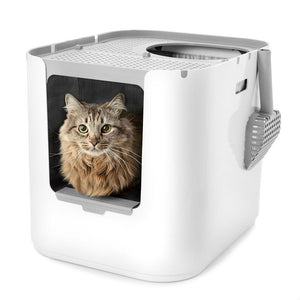
"It looks nicer than any other hooded or open option we considered."

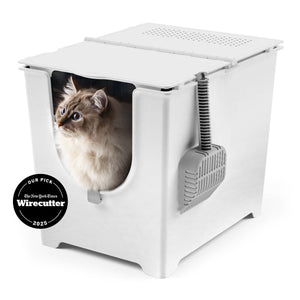
"This litter box keeps everything in, nothing gets out the sides."

"My beautiful ragdoll cat and I both love the new Modkat Litter tray!"


